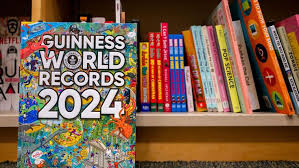Guinness World Records has declared Sultan Kösen the tallest living man in the world (8 feet, 2.8 inches), Bilal Ilyas Jhandir the best at identifying Taylor Swift songs in a minute or less (34 songs) and a team at a 2017 Adidas event the top distance traveler on a treadmill in an hour while carrying a 20-pound backpack (36.6 miles).
They’re among the roughly 65,000 records tracked by the company − so many, in fact, that the famous annually printed Guinness World Records book doesn’t include them all.
You might not realize it, but that book started out as an offshoot of Guinness beer to settle pub bets about seven decades ago. But now Guinness World Records also tracks lots and lots of dreamed-up superlatives − and those records seem to keep getting more specific, and at times bizarre.
Today’s records include the most people in a floating line (unassisted), most people in a digging relay, most prolific beat-’em-up video game soundtrack composer and most people lifted and thrown in two minutes (female).
The company says the massive list of records helps keep Guinness World Records relevant in an online world. Granting superlatives for whimsical topics − person to hug the most trees in an hour, person with the most matches held in the nose, person with the fastest time to visit every location on the London Monopoly board by bicycle − is a part of the brand’s appeal, said Craig Glenday, the company’s editor-in-chief.
But staffers at Guinness World Records also acknowledge that a large collection of niche records is a big part of how the organization makes money. It now operates a consulting business that helps match paying companies with records they can break to generate publicity.
Nearly half of the company’s total sales came from the consulting services in 2022, said Amanda Marcus, a spokesperson for Guinness World Records. (Meanwhile, 43% of its total sales came from publishing and 8% came from its digital, TV and entertainment services.)
The end result: very specific, sometimes oddly specific, records that benefit both Guinness World Records and the companies that break those records.
Guinness World Records is in a unique global position: It has a virtual monopoly on superlatives in the public imagination and answers to no governing body or advisory board. But the company says it works with experts from various disciplines, including dendrologists (trees), gerontologists (aging) or funambulists (tightrope walking) and has a team “overseeing records to assess evidence and verif(y) the success or failure of record attempts.”
Here’s how Guinness World Records became famous and held its popularity for tracking records − even the ones it made up.
How did the Guinness Book of World Records get started?
Guinness Breweries managing director Sir Hugh Beaver created the company in the early 1950s in Ireland. According to the company, Beaver attended a party. There, “he and his hosts argue(d) about the fastest game bird in Europe, and fail(ed) to find an answer in any reference book.”
At the party, “Sir Hugh had the idea for a Guinness promotion based on the idea of settling pub arguments and invited the twins Norris and Ross McWhirter who were fact-finding researchers from Fleet Street to compile a book of facts and figures,” according to the Guinness World Records website.
The McWhirters founded Guinness Superlatives, Ltd. and published the first now-annual Guinness Book of World Records in 1955. The brand sold 187,000 books after four reprints within a year. In 1964, book sales across all editions and languages peaked to 1 million copies, according to the company’s website.
“First published in 1955, the annual Guinness World Records book has become one of the biggest-selling copyright titles of all time, selling 120 million copies to date in 22 languages and in more than 100 countries,” according to the company.







